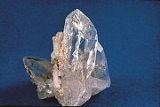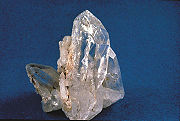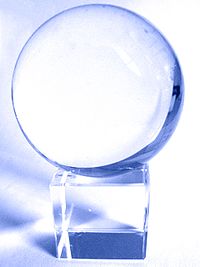
Crystal ball
Encyclopedia



Crystal
A crystal or crystalline solid is a solid material whose constituent atoms, molecules, or ions are arranged in an orderly repeating pattern extending in all three spatial dimensions. The scientific study of crystals and crystal formation is known as crystallography...
or glass
Glass
Glass is an amorphous solid material. Glasses are typically brittle and optically transparent.The most familiar type of glass, used for centuries in windows and drinking vessels, is soda-lime glass, composed of about 75% silica plus Na2O, CaO, and several minor additives...
ball
Ball
A ball is a round, usually spherical but sometimes ovoid, object with various uses. It is used in ball games, where the play of the game follows the state of the ball as it is hit, kicked or thrown by players. Balls can also be used for simpler activities, such as catch, marbles and juggling...
believed by some people to aid in the performance of clairvoyance
Clairvoyance
The term clairvoyance is used to refer to the ability to gain information about an object, person, location or physical event through means other than the known human senses, a form of extra-sensory perception...
. It is sometimes known as a shew stone. A body of water, either in a container or on the ground, used for this purpose, is called a scrying pool.
History
CeltCelt
The Celts were a diverse group of tribal societies in Iron Age and Roman-era Europe who spoke Celtic languages.The earliest archaeological culture commonly accepted as Celtic, or rather Proto-Celtic, was the central European Hallstatt culture , named for the rich grave finds in Hallstatt, Austria....
ic druids are one of the earliest known peoples to have used crystals in divination.
Later, during central Europe's medieval period
Middle Ages
The Middle Ages is a periodization of European history from the 5th century to the 15th century. The Middle Ages follows the fall of the Western Roman Empire in 476 and precedes the Early Modern Era. It is the middle period of a three-period division of Western history: Classic, Medieval and Modern...
(AD 500–1500), seers, wizards
Magic (illusion)
Magic is a performing art that entertains audiences by staging tricks or creating illusions of seemingly impossible or supernatural feats using natural means...
, sorcerers, psychics, gypsies, fortune tellers, and all other types of diviners also used crystals to "see" into the past, present, or future.
Due to its transparent nature, a natural gemstone called beryllium aluminum silicate (beryl
Beryl
The mineral beryl is a beryllium aluminium cyclosilicate with the chemical formula Be3Al26. The hexagonal crystals of beryl may be very small or range to several meters in size. Terminated crystals are relatively rare...
) was often used for divination
Divination
Divination is the attempt to gain insight into a question or situation by way of an occultic standardized process or ritual...
. Scottish Highlanders termed these objects "stones of power." Though early crystal balls were made from beryl, they were later replaced by rock crystal
Quartz
Quartz is the second-most-abundant mineral in the Earth's continental crust, after feldspar. It is made up of a continuous framework of SiO4 silicon–oxygen tetrahedra, with each oxygen being shared between two tetrahedra, giving an overall formula SiO2. There are many different varieties of quartz,...
, an even more transparent rock.
Art of scrying
The art or process of "seeing" is known as "scryingScrying
Scrying is a magic practice that involves seeing things psychically in a medium, usually for purposes of obtaining spiritual visions and less often for purposes of divination or fortune-telling. The most common media used are reflective, translucent, or luminescent substances such as crystals,...
," whereby images are seen in crystals, or other mediums such as water, and are interpreted as meaningful information. The "information" gleaned then is used to make important decisions in one's life (i.e. love, marriage, finances, travel, business, etc).
By contrast, some professed seers say that they do not actually see images in the crystal itself, but rather that the featureless interior of the stone facilitates them in clearing their mind of distractions so that future truths or events will become known to them.
When the technique of scrying is used with crystals, or any transparent body, it is known as crystallomancy or crystal gazing
Crystal gazing
Crystal-gazing is a form of divination or scrying achieved through trance induction by means of gazing at a crystal....
.
In protoscience
Dr. John DeeJohn Dee (mathematician)
John Dee was an English mathematician, astronomer, astrologer, occultist, navigator, imperialist and consultant to Queen Elizabeth I. He devoted much of his life to the study of alchemy, divination and Hermetic philosophy....
(July 13, 1527 – 1608 or 1609) was a noted British mathematician, astronomer, astrologer, geographer, and consultant to Queen Elizabeth I. He also devoted much of his life to alchemy, divination, and Hermetic philosophy. He was known for his use of crystal balls in his work.
In stage magic
Crystal balls are popular props used in mentalismMentalism
Mentalism is a performing art in which its practitioners, known as mentalists, appear to demonstrate highly developed mental or intuitive abilities. Performances may appear to include telepathy, clairvoyance, divination, precognition, psychokinesis, mediumship, mind control, memory feats and rapid...
acts by stage magicians
Magic (illusion)
Magic is a performing art that entertains audiences by staging tricks or creating illusions of seemingly impossible or supernatural feats using natural means...
. Such routines, in which the performer answers audience questions by means of various ruses, are known as "C. G." (Crystal Gazing) acts. One of the most famous C. G. performers of the 20th century, Claude Alexander
Alexander (magician)
Claude Alexander Conlin , also known as Alexander, C. Alexander, Alexander the Crystal Seer, and Alexander the Man Who Knows, was a vaudeville magician who specialized in mentalism and psychic reading acts, dressed in Oriental style robes and a feathered turban, and often used a crystal ball as a...
, was often billed as "Alexander the Crystal Seer."
Safety
A transparent sphere of any material with refractive indexRefractive index
In optics the refractive index or index of refraction of a substance or medium is a measure of the speed of light in that medium. It is expressed as a ratio of the speed of light in vacuum relative to that in the considered medium....
greater than 1 brings parallel rays of light to a rough focus
Focus (optics)
In geometrical optics, a focus, also called an image point, is the point where light rays originating from a point on the object converge. Although the focus is conceptually a point, physically the focus has a spatial extent, called the blur circle. This non-ideal focusing may be caused by...
(that is, a focus with significant coma
Coma (optics)
In optics , the coma in an optical system refers to aberration inherent to certain optical designs or due to imperfection in the lens or other components which results in off-axis point sources such as stars appearing distorted, appearing to have a tail like a comet...
). For typical values of the refractive index, this focus usually lies very close to the surface of the sphere, on the side diametrically opposite that where the rays entered. If the refractive index is greater than 2, the focus lies inside the sphere, so the brightest accessible point is on its surface directly opposite the source of light. However few materials have that property. For most materials, the focus actually lies slightly outside the sphere. The closer the refractive index is to 2, the closer the focus is to the surface of the sphere and hence the brighter the spot formed on an object touching the sphere.
This effect is used in the Campbell–Stokes recorder to record the brightness of sunlight by burning the surface of a piece of cardboard placed near the sphere. The same effect can occur with a crystal ball that is brought into full sunlight; it may either burn a hand that is holding it, or even start a fire if it is resting on or very close to dark coloured flammable material. Consequently, such a ball should always be covered before being taken outdoors on a sunny day, and should not be left uncovered near a window.
External links
- Wiccan Essentials The Art of Scrying
- Andrew Lang, Crystal visions, savage and civilised, The Making of Religion, Chapter V, Longmans, Green, and C°, London, New York and Bombay, 1900, pp. 83–104.
- Online Crystal Ball DecideFor.us
- A Translation of Grimm's Fairy Tale No. 197 The Crystal Ball
- A Translation of Grimm's Saga No. 119 Crystal Ball Gazing

